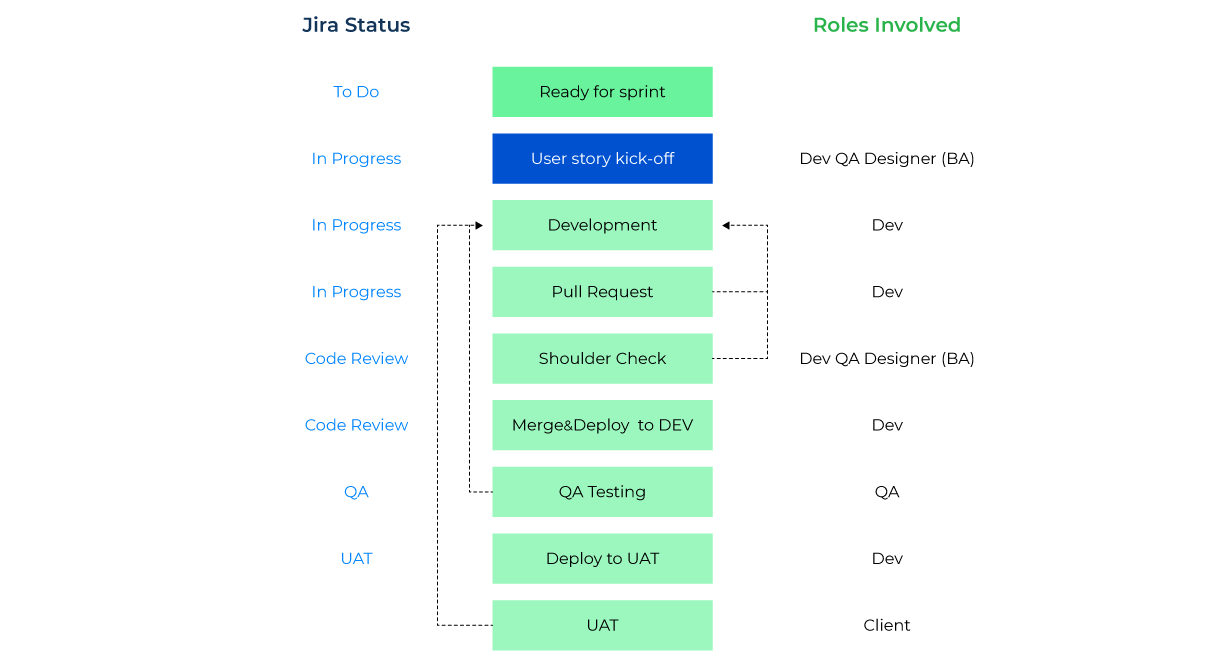In part one of our series “How to improve quality as a team,” we talked about the effectiveness of adding shoulder checks to the agile development workflow and how that helps improve the overall quality of the product.
This article introduces you to another fantastic exercise called "the user story kick-off". This practice helps larger teams align on more complex features, and in turn increase quality output as a team.
What is a user story kick-off?
User story kick-offs (also called “Three Amigos” or “Design/Dev Boxes”) are short meetings (10–15 minutes) that developers initiate to align everyone on the team before they start to code a feature.
These meetings normally include a developer, a QA, designer, and Business Analyst (BA) or Product Owner (PO). Additionally, if integration for the front end and back end is involved, it is helpful to have the back end engineer who developed the API that the front end is planning to use, for this user story in the kick-off as well.
The overall purpose of user story kick-offs is to align on requirements and to ensure that everyone has what they need to start developing a feature.
How user story kick-offs work
“Talk about the concerns of the ticket, be it testing, business or user ones. Note down on the ticket any important points. You are testing assumptions and the shared understanding of the work. Clearing up misunderstanding early on saves time later on fixing defects and bugs.
-Thomas Shipley, Delivery Consultant
User story kick-offs are most useful when working in very large teams with multiple platforms. Here’s how this practice works:

- Developers will initiate a user story kick-off just before they pick up a Jira ticket and start coding;
- They clarify any questions around the feature they are building and ensure they are aligned with backend implementation;
- They can also go through their interpretation of the acceptance criteria;
- Ideally, the session includes all developers working on this feature (i.e., iOS, Android, Backend);
- Developers discuss the technical details and implementation strategy;
- Designers present prototypes, screenshots, video recordings, or animation and will walk them through with the team to ensure everyone understands the flow;
- QA strategizes how to test with developers and asks for test data;
- QA’s can also present test cases they are planning on testing and get them reviewed by developers;
- This is also a chance to discuss the risks, edge cases, negative cases, test data, and automated tests requirements before implementation;
- Product Owner/BA will ensure that the requirements are understood and aligned;
- Pro tip: Anyone in the user story kick-off can take down notes and post-it in Slack/Jira ticket to ensure no details are forgotten after the meeting.
Another example of a user kick-off summary:
Coming out of the user story kick-off, the relevant team members should have a clear idea of how to implement a feature, how to test it, and how it is supposed to look and interact.
How are user story kick-offs different from sprint grooming?
You might be wondering, “Isn’t this what sprint grooming is for?” On larger projects, imagine having thirteen people grooming multiple stories for two hours remotely. It’s human nature to lose your sharpness and even interest over this extended period of time.
User Stories should be discussed and groomed enough to be able to estimate effort (or point values) in grooming sessions, but getting into the smaller details can be tough during long meetings with large groups.
User sorry kick-offs allow team members to remind each other of some small details that may or may not have been covered in grooming.
The benefits of user story kick-offs
Overall, this practice helps align cross-functional teams. There should be a reduced misunderstanding of user flows, implementation, and test strategy. The addition of user story kick-offs may reduce the time in the Shoulder Checks since most of the acceptance criteria and different scenarios have already been closely discussed among the relevant team members.
Developers
For developers, this automatically sets aside 10–15 minutes for every big feature where they can discuss with other relevant developers how to implement this feature and some technical aspects. This also allows developers to clarify design/requirements and have it fresh in their minds as they are about to start development shortly after the meeting. The business, integration, design, and test requirements should be clear to the developer at this point.
Designers
For designers, user story kick-offs for bigger features allow them to present the complex flows and designs again closer to development. They can point out nuances and specific design notes to the targeted developers working on this feature.
QA’s
As a QA, the addition of user story kick-offs should encourage you to research and/or at least think about test cases earlier on because you want to be prepared with test cases and questions to discuss at these user story kick-offs. Ideally, QAs would start writing test cases at the start of a sprint.
Realistically, writing test cases either comes right before the feature is ready for testing or even sometimes after it has been tested due to time constraints. Additionally, you will have fewer clarification questions during shoulder checks or while testing because this feature was discussed in great detail during the user story kick-off.
Tips for successful user story kick-offs
- Try and investigate a ticket before the user story kick-off, and come prepared to discuss your questions, testing notes, strategies, and user flows;
- Time-box the session;
- Write up a quick summary of the important points discussed during the user story kick-off and post it to the team so nothing is forgotten;
- If anyone feels that a feature is big enough to do a user story kick-off, call it out during the Sprint Grooming;
- As with shoulder checks, keep this flexible.
Increased team collaboration equals better quality products
An increase in team collaboration helps create better quality products that meet the requirements, the business needs of the client and produce functional, user-friendly products that have been through multiple layers of quality.
Xray is the perfect tool for easy collaboration between testing and development teams. That's because Xray natively integrates with Jira, so you can assign test cases directly to your requirements from Jira. With the agile board enhancements from Xray, all team members working in Jira can see and participate in the testing process and gain full visibility into the entire software development lifecycle, including testing.
Learn more about the collaborative benefits of Xray - Native Test Management.


